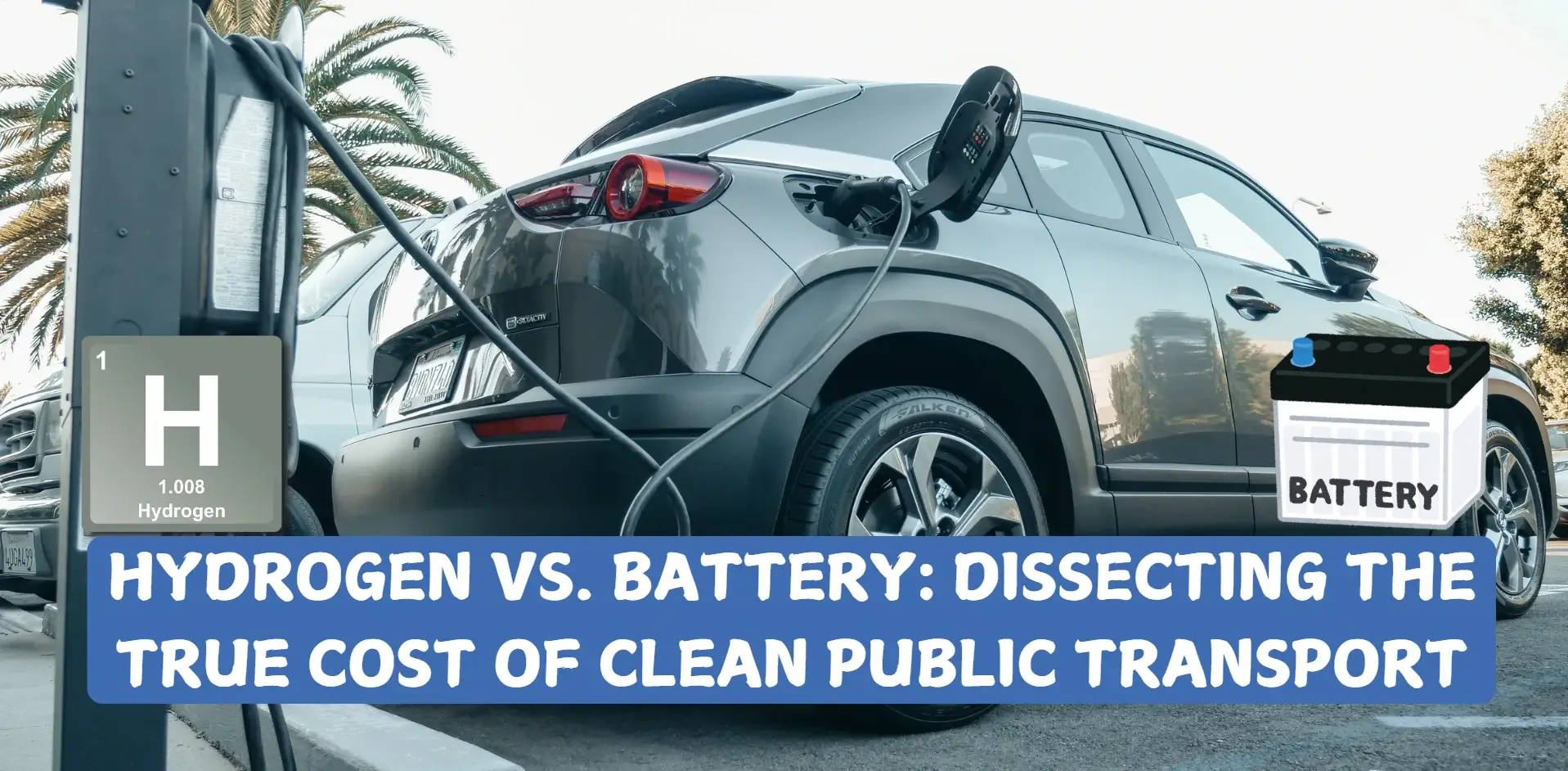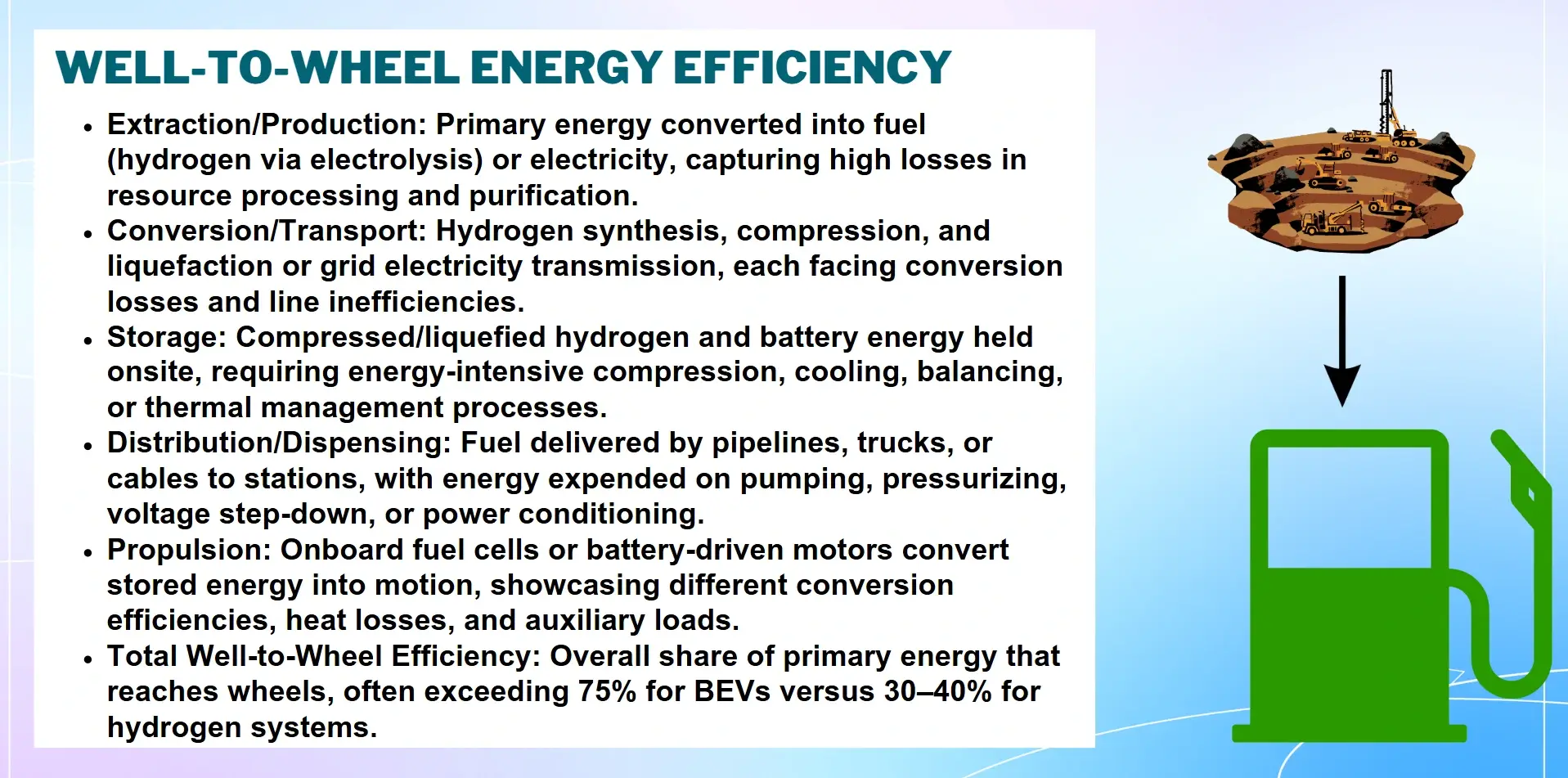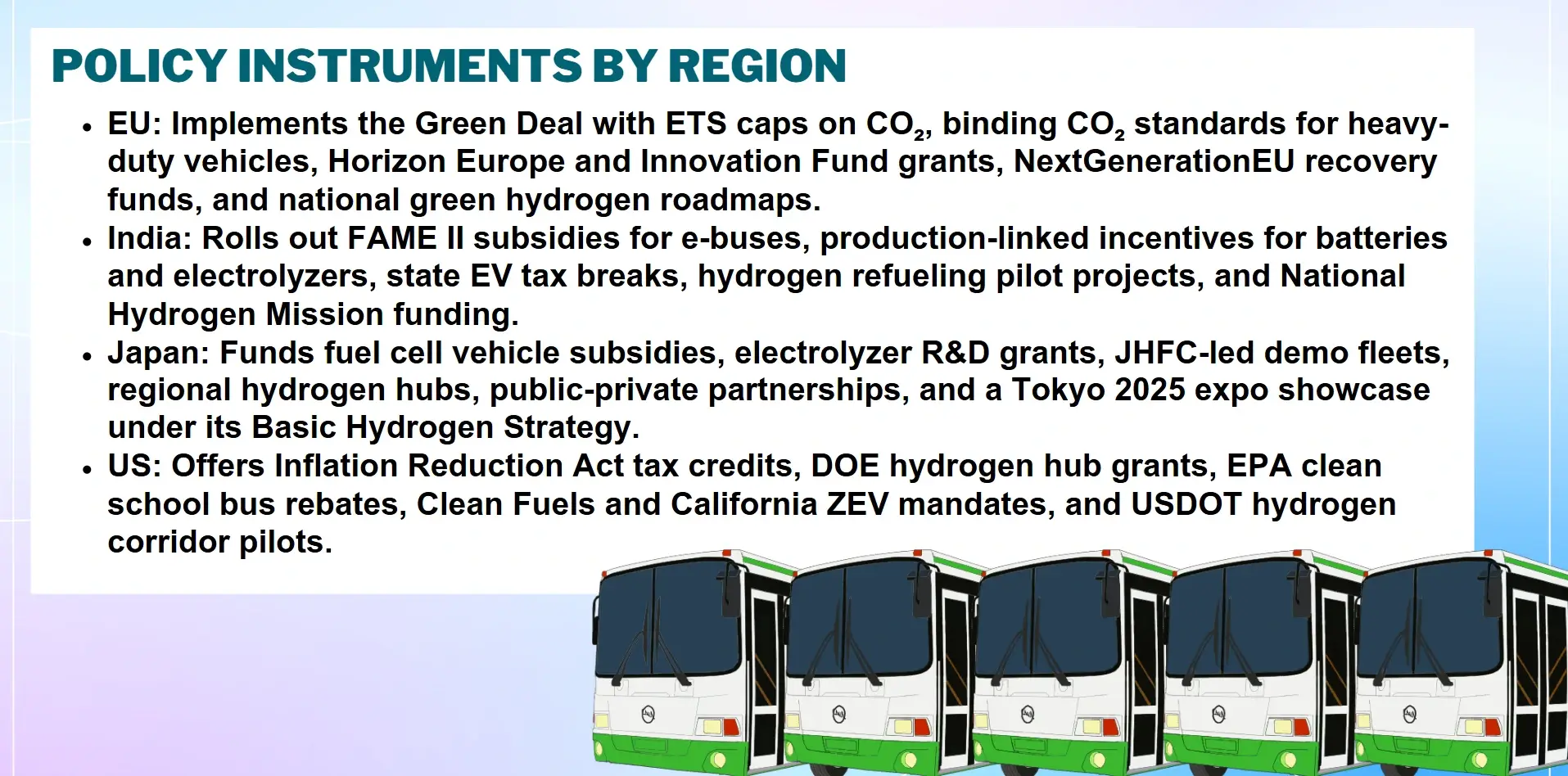The article draws the comparison between hydrogen and battery powered public transport through cost, infrastructure, performance, policies and viability in a variety of geographical and operative contexts.

Zero-emission public transport is something that is fast catching up in the world and especially in India, as it involves resilience towards climatechange with good health in the urban areas and an independent source of energy. Hydrogen fuel cell electric vehicles (FCEVs) and battery electric vehicles (BEVs) are among the top clean mobility contenders,and they promise different benefits and compromises along the way. Although battery-powered buses and trucks have an advantage in urban applications, as the costs of the vehicles are lower and the charging infrastructure is already in place, hydrogen vehicles are increasingly adopted in long-range hauls and high-loads, despite the considerably higher price of the automobile (roughly 20-30 percent).This article is a critical evaluation of the economic aspects of hydrogen, rather than battery propulsion of the public transportation system, the costs of supplying vehicles, the requirements in terms of infrastructure, the economics of operation, and its environmental ramifications. In addition to price tags, it is also analyzingwell-to-wheel energy losses, the suitability of the use case, and policy incentives, which structure investment analysis. Since governments and manufacturers are making wagers in the billions on other technologies, a measure of the cost-benefit equation is critical. This article provides a comparative perspective based on technology, geography, and strategic perspectives with the objective of making the situation clearer on what actually makes the public transport so clean, sustainablein costs, and becoming future-friendly.
Technology Overview
The new gear towards zero-emission public transport depends on two key rivals: hydrogen Fuel Cell electric vehicles (FCEVs) and Battery Electric Vehicles (BEVs) that are based on entirely different types of propulsion.
- Power is produced on-board the vehicle when the hydrogen fuel cell combines with oxygen in the stack of fuel cells in an electrochemical reaction. The emission during this process is simply water vapour, this provides long driving distances and quick times to fill up the tanks. The hydrogen is stored in pressurised tanks specifically designed and this creates some difficulties to material durability, safety measures and infrastructures requirements. Besides, the production of hydrogen, compression and transportation lead to efficiency losses.
- On the other hand, BEVs depend on the lithium-ion batteries that are rechargeable to store electricity supplied by the grid. Their efficiency of transferring energy is very high and the technology has several years of development making it to have simplified maintenance. The charging infrastructure is becoming more common, particularly in towns and cities. Nevertheless, the weight of the battery has an effect on wooden capacity, and the long charging times can be an issue with regards to schedule operations, especially in traffic-dense move administration.
After all, hydrogen is the safer solution when it comes to long-haul transportation, whereas batteries are cost-efficient, and depot-based. The technological divergence is not only responsible in creating differences in the performance between the components of the clean transport spectrum but also within policy, investment as well as operational choices.
Cost Analysis
Although hydrogen and battery electric have zero-emission mobility potential, their cost models vary greatly and are determined by the complexity of manufacturing, infrastructural requirements and dynamics of long-term operations.
Initial Cost of Entry into Vehicle Industry
Fuel cells cars (FCEVs) already cost as much as 20-30 percent more than battery electriccars (BEVs), in large part with all those complex parts of the fuel cell system, as well as high pressure hydrogen storage tanks. Such materials need intensive engineering and safety measures that increase cost of production. In turn, BEVs enjoy increased capabilities of mass production of lithium-ion batteries and simpler design of the load scheme, which reduces the costs of procurement of the vehicles in public transport.
Infrastructure Economics
The gas portion of hydrogen gas stations includes gas compression, storage and dispensing systems and the cost of such a station can be between 2 and 4 million dollars. Furthermore, the distribution of hydrogen makes special transport and investment in pipelines necessary. The battery charging infrastructure is affordable, with a minimal expense of the basic depot Battery charging charger of $50,000 to the fast-charging hubs of $500,000. The grid connection and the energy storage retrofits could prove to be an additional expense, although the BEV infrastructure is modular so it can be deployed in phases at lower capital.
Operational and Life-Cycle Costs
Prices of hydrogen fuel are still fluctuating and more expensive on a kilometre basis than electricity, especially when it is not generated renewably. Their systems are more intricate and have fewer trained technicians, which mean maintenance may be more complex. BEVs have cheaper running expenses and the uniformity in the parts used and maintenance schedules is high. Nevertheless, the wear and tear of the batteries at different periods of time and the cost of their replacement has to be taken into consideration. BEVs are frequently favoured in the lifecycle analysis in terms of urban use, although hydrogen might be cost-effective towards long-range, high-utilization fleets.

Environmental and Efficiency
In addition to monetary considerations, the environmental impact and energy efficiency are mainstream issues in assessment of both the hydrogen and battery technologies. It is not just the absence of tailpipe emissions that makes them truly sustainable but also dynamics of upstream energies, and end-of-life.
Energy Efficiency
Battery electric vehicles (BEVs) are very energy efficient with 70-90 percent of grid electricity being turned into motion. However, hydrogen fuel cell electric vehicles (FCEVs) are more limited because they only work at 30-40% totalefficiency with energy losses during hydrogen production, compression, storage and conversion. The introduction of these inefficiencies makes hydrogen a sub-optimal solution in areas with high renewable electricity resources, where direct battery charging eliminates the loss of energy, bypassing a hydrogen step.
Emissions Footprint
Even though the emissions of the two technologies are zero, upstream energy sources are paramount in determining the environmental impact of such systems. Green hydrogen produced through renewables-fed electrolysis is a carbon-neutral solution, though there is little of it and it is quite expensive. Majority of Hydrogen today is either grey or blue as it is made through fossil fuels which emit large volumes of CO2 and methane. Coal-heavy grid-powered BEVs are also under review but the energy efficiency of the vehicles makes up the raised emissions in the grid in most instances.
End-of-Life Considerations
There are retirement issues, especially with the lithium-ion batteries; they cannot be discarded; they must be subject to refined re-processing to recover valuable metals and avoid toxic waste. The use of batteries in a second life is positive, it is not fully implemented yet. Hydrogen systems have less rare materials, but they have an issue of disposal regarding the integrity of composite tanks and fuel cell membrane durability problems. Lifecycle assessments demonstrate that battery systems have more potential to be more circular, with both technologies requiring a strong recycling setup.
Use Case Scenarios
The technology question of whether hydrogen or battery-powered vehicles is preferable is not the only issue that can determine the preferred mode of transport; terrain, climate, and route morphologies, energy options, and local needs, transportation should be other factors to be considered.
Long-Haul and Rough Terrain
FCEVs shine in long-range transport, particularly in areas with longer transport routes and a poorly developed charging network. They have light-weight energy storage and quick fuelling, making them superb to be used with intercity buses, in freight corridors and cold climates where battery performance is compromised. Hydrogen plays a role in the connection of regions in countries with low density, like Australia or parts of the US and Canada, where the existing grids cannot be saturated.
Depot and City-Based operations
Battery electric Vehicles (BEVs) do particularly well in urban and in short-range environments when a route can be forecasted and when charging can be centralized. Amsterdam, Shenzhen, New Delhi and other cities are quickly introducing batterybuses to dense, frequent routes. The idea of overnight charging is convenient due to the depots and does not interfere with municipal flows, making the implementation process easier and decreasing idle times.
Regional Policy Mix and Energy
The presence of renewable energy is a major factor. FCEVs are more appealing than FBEVs because regions rich in solar energy and wind are able toproduce green hydrogen. Conversely, coal-intensive grids have the potential to negate BEV sustainability without being accompanied by a redesign the grids. Adoption is also guided by government requirements,support, and industrial ecologies, appearing in the form of hydrogen hubs in Japan, Europe, and so forth, depending on national decarbonization plans.
The Landscape and Future Outlook Policy -h3
The dynamics of changing hydrogen and battery electric mobility economics require varied policy regimes, scale of industry development, regional energy suppliers, and technology-strategic decisions, which will influence convergence and divergence of cost.
Policy Instruments
The current cost trends are being affected by the presence of policy models used around the world. A network of charging facilities is funded through consumer subsidies and sets up battery cars with additional incentives, especially in the city centres. In comparison, the funding of hydrogen is through industrial decarbonization grants, fleet procurement programs, and corridor strategies. The long-term commitment by the public in response to hydrogen can be seen in the number of hydrogen valleys in Europe and the National Green Hydrogen Mission in India. Nevertheless, the maturity of policies is not uniform in nations, which means that cost differentiation is transient.
Market Drivers
Battery technology is also experiencing ascale-upin consumer electronics, where costs to produce lithium-ionbatteries dropped more than 80 percent in ten years. Vertical integration and electricity demand across the globe are the factors that are hastening the affordability of BEVs. The price path of hydrogen is less stable, and it depends on the implementation of electrolysers, the distribution system, and the availability of green hydrogen. Mature gas networks (e.g., Germany, South Korea) will have an advantage, although hydrogen initially will be niche; infrastructural costs will need to become flat against scale.
Local Energy Economics
The adoption of battery is successful in countries where power is both affordable and stable, essentially the countries with developed grids and renewable penetration. However, Hydrogen exploits geographical areas with renewable abundance (e.g., Australia, Chile) or where it is not possible to export power. Such geographic differences will lead to the divergence of costs as hydrogen may become scaled at smaller geographical areas, deposing the batteries in more expansive city situations.

Strategic Convergence
Over the short term, asymmetry in infrastructure costs will be in existence may it be through base infrastructure asymmetry or through use case asymmetry. In the long-run convergence can happen on a sectoral basis: batteries are predominantly in the urban/personal mobility segment; hydrogen in the industrial, freight, and aviation segments. Technology spillovers, policy harmonization, and carbon pricing will play a major role in cost equalization across sectors. Non-conformance is not a failure; it could be an optimisation strategy across applications.
Conclusion
The process of switching to sustainable mobility is not a hydrogen-battery zero-sum game at all: it is a geographically and sector distinct transformation process. The practically instantaneous consumer adoption scale of battery electric vehicles in India is fast changing mobility in the cities, and hydrogen proposes a strong economic value in terms of freight, industrial, and long-distancetravel, where electrification is limited. Policy ecosystems, energy infrastructure, and regional resourceprofiles will determine the ways to either converge or not converge costs, infrastructure, and technology. The best way to go forward is to strategically align things, not forcibly make them homogenized. Instead of attempting to identify a single victor, transport systems of the future will flourish by virtue of coexistence, specialisation,and flexibility. The challenge facing governments, industries, and innovators is to develop frameworks that pursue short-termfeasibility by focusing minutely on long-term sustainability, so that the transportation systems become not just clean, but situationally intelligent. In place-based visions, technology decisions are based on place-based logics, and cost convergence can be treated as purposeful design and not just a market accident.